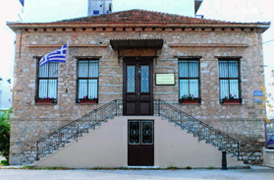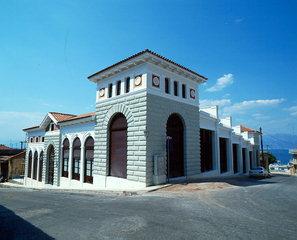|
|

 History of the Museum History of the Museum
The Municipal Historic - Folklore Museum of Aeghio is situated in a traditional two hundred year old
building made of stone.
The architecture of traditional build dwellings is typical all over the Peloponnese. They are two-stony buildings of stone with one-meter thick walls and several large windows.
The exterior features of the dwellings include a stone stair and a balcony with an inclining roof, witch compose the so-called traditional "loggia". In the interior, wood is the prevailing material on floors and ceilings.
The rooms of traditional dwellings were designed to meet various needs. The ground floor was used for the daily needs, that is, as kitchen, a dining room, a sitting room or even for storing oil, wine, and cereals.
The upper floor had a more formal use. There were usually bedrooms, a living room with a fireplace for the winter as well as other private rooms.
The building was surrounded by a big yard where one would find the stables, a few storerooms and the oven for baking bread.
The Historical - Folklore Museum in Aeghio is a traditional building like the ones described above.
The construction of the building dates back to 1830. Initially, it belonged to Meletopoulos' family, who were wealthy merchants of raisins, witch was the main source of income in the region. The family later participated in the local politics (Kotsampasides).
A few years later, it was handed down as a dowry to Anastasios Londos, who married the daughter of Dimitrios Meletopoulos.
Anastasios Londos was studding medicine in Italy when the Greek Revolution broke out, in 1821, and he came to Greece to fight together with other Greek warriors against the Turks. After Greece had been liberated, he became an eminent politician and played a significant part in the political scene of the period when Greece was governed by King Othon. Furthermore, Anastasios Londos became the first Mayor of Aeghio and he was Member of Parliament as well as Minister.
Anastasios Londos was the brother of Andreas Londos who was one of the chief fighters of the Greek Revolution in 1821 and also of the Revolution of September 3rd, 1843, aiming at Othona's Concession for a Constitution.
Andreas Londos was a leading figure in 1821. He fought a lot of battles against the Turks with his own army. The first flag raised against the Turks on March 21st, 1821 was red with a black cross, a replica of witch is exhibited in the Museum today.
This flag belonged to his army. During Othona's reign he served as a Minister of External Affairs and Military Forces. Nevertheless, he committed suicide in 1846 for financial reasons, since he had offered his entire fortune for the war of independence... The clergy refused to give permission for his religious burial, though. Therefore, Anastasios Londos buried him in the basement of this house. In 1959 the headstone of Andreas Londos grave was found broken in seven pieces. On it were written the following words:
ΚΑ' ΜΑΡΤΙΟΥ ΑΩΚΑ +Γ.
ΣΕΠΤΕΜΒΡΙΟΥ ΑΩΜΓ
ΑΥΤΟΝΟΜΙΑΣ ΙΣΟΝΟΜΙΑΣ
ΕΛΛΗΝΙΚΗΣ ΤΟΥ ΔΥΟ
ΚΑΛΛΙΣΤΟΥΣ ΑΓΩΝΑΣ
ΠΡΩΤΑΓΩΝΙΣΤΗΣΑΝΤΑ ΑΝΔΡΕΑΝ
ΛΟΝΤΟΝ ΟΔΕ ΚΑΛΥΠΤΕΙ
ΠΑΥΣΙΛΥΠΟΣ ΛΥΘΟΣ.
The dates refer to the two most important historic events in witch Andreas Londos played a leading role: March 21st 1821 the date he started with his flag to liberate the city of Patras and September 3rd, 1843 is when he participated in the revolt of Greek people requesting a constitution.
In this way the history of this house is connected with the historical, glorious Londos family. That is why its historical value doubles.
Nowadays it is the only building in Aeghio with a history more than two hundred years. Furthermore, it was a primary scool until the nineties.
It was turned into a museum in 1997 and since then the Historical - Folklore Museum of our area has been housed in this building. The building was renovated after the destructive earthquake in Aeghio in 1995. Its traditional architecture has been preserved but some of its features, such as the floors and the windows have been altered. The building now belongs to the Municipality and the Hospital of Aeghio as legacy.

The Historic - Folklore Museum in our times.
On the ground floor is the Folklore Museum witch, in its four halls, includes remarkable exhibits from the runal life of the region, like various utensils, looms, pieces of furniture, machinery, textile materials, woven clothing and costumes.
On the first floor the Historic Museum is housed in four halls with significant items of historical value witch cover all historical areas. It includes a great number of relics from the Turkish Occupation till today, such as weapons, documents, costumes, coins, medals, furniture, paintings and photographs.
There also is a library situated in the museum with important historical and folklore books witch is definitely worth visiting.
The Museum is open daily for pupils, students, tourists and scholars. Apparently, this is one of major aims of its existence. Apart from collecting and preserving our ethnological inheritance, the museum is supposed to and must be a lively place witch everybody will have access to and where visitors will be able to spend their time admiring all objects.
Quite a few people have worked very hard to realize this museum and now it is up to all of us to preserve it, to enrich it and to keep it alive!

 History of Aeghio History of Aeghio
Aeghion: etymology of the word is based on verb αΐσσω (aisso), which means: moving rush, always shake and has to do with the waves movement. According to mythology it owes its name to Αίγα (aega), which leaved here, a goat that nursed and brought up Zeus, who was hidden there away from Saturn. More realistic idea is that Aeghio took its name from the coastal area, Seashore: Αιγιαλός (Aeghialos). But Aeghialea took its name from king Aeghialeus, king of Sikyon and the residents of it Aeghialists. His kingdom was extended at length of beach, from Sikyon up to Hilida.
Before the founding of the city, the area had a Neolithic settlement. The first settlers were also Pelasgoi Aeghialists, the first natives residents of Aeghialea (about 3.000 BC). Aeghion was founded during Homeric times. It became a part of the Achaean League in around 800 BC. After the city of Helike was foundered because of earthquake, in Aeghio used to take place the assemblies of Achaean cities, of the 1st Achaean Confederacy, with seat and Parliament in the Aegio, from 800 - 303 b. C.. During that period, it had several Olympic athletes including Straton (Στράτων), Athenodorus (Αθηνόδωρος) and more. From 330 BC until 281 BC, it was part of the Kingdom of Macedonia. It was later the capital of the Achaean League from 281 BC until the annexation with the Roman Empire in 146 BC, after the fall of Greece, the Romans removed the wall of the city and Aigio lost its importance. Aegion split from the Roman Empire and became a part of the Eastern Roman Empire, and all Greece was altered in Romenan province with the name Achaia.
Later at the Byzantine Age, Aeghio is almost lost historically. In 805 AC. Slavs reached in northern beach of Peloponnese, during that time, it was renamed Vostitsa (Βοστίτσα), its origin of the name came from the Old Church Slavonic words vosta and vostan which meant the city of gardens or the garden city. The period of Kingdom of Basileios (Boulgaroktonos) and his successors in Achaia thrives the agriculture of silk industry and the weaving of silk cloths. Because of the extent of Mulberries in Peloponnese was renamed to Moreas.
It was handed to the Franks in the 1200s and later in the 1457 joined the Ottoman Empire with brief interruptions by the Venetians from 1463 until 1470 and from 1685 until 1715 before being conquered and returned to Ottoman hands.
Then Vostitsa becomes center of revolutionary activities, with climax the said "Secret assembly of Vostitsa of" 26 - 30 January 1821. After that Andreas Lontos returns in Patras, where 25 March, with other chiefs of Achaia, declares the beginning of revolution, with bishop Old Patreus Germanos. It was renamed after the Greek Independence. It was the first city to be liberated on March 26 during the revolution of 1821. Its economy improved after 600 years of non-Greek rule, 370 years without a nation and 300 years of Turkish rule.
Agriculture was expanded and several farmlands were created around the area. Its population expanded later on and received its train station. Until the World War II the main agriculture product was the vostitsa sultans, trade and export product. Simultaneously begin industry transformation of Aegio, the big Paper mill, soap industry, timber and irons manufacture, industries of sweets etc. In the mid time the harbor of Aegio present big movement from the loading of grape and sultans as transport center. Natural it was to develop in the Aegio big cultural and artistic movement and all that change the traditional way of life in the territory. After World War II and the Greek Civil War, many buildings were rebuilt and four to five story buildings were built. A bypass was opened in 1972, its hospital was opened and the economy expanded rapidly.
Today an afford to gather all this to the new Historic - Folklore Museum of Aeghio, that is situated in the traditional and historical old house of Andreas Londos is taking place.
The elements of the historic identity of the city from antiquity, capital of Achaean Confederacy (of Aeghion and not Vostitsa, witch is a Slavic name and under no condition must be promoted in weigh of its ancient name of the city: AEGHION), one can admire at the Archeological Museum of Aeghio, housed at the restored neoclassical agora designed by Ernst Ziller (old market).
Vana Mpentevi

|
|
|